Application of Blockchain Technology in Environmental Health: Literature Review and Prospect of Visualization Based on CiteSpace
Abstract
:1. Introduction
2. Objects and Methods
2.1. Data Source
2.2. Research Methods
3. Results and Analysis
3.1. Trend in the Number of Articles Published
3.2. Author Collaboration Network
3.3. Research Institution Network
3.4. Keyword Co-Occurrence
3.5. Keyword Clustering
3.6. Timezone View
3.7. Keyword Burst
3.8. Co-Citation Analysis
3.9. Distribution of Countries and Regions
4. Discussion
5. Future Development Trends and Challenges
6. Conclusions
Author Contributions
Funding
Institutional Review Board Statement
Informed Consent Statement
Data Availability Statement
Conflicts of Interest
References
- Fawcett, T. Personal carbon trading: A policy ahead of its time? Energy Policy 2010, 38, 6868–6876. [Google Scholar] [CrossRef]
- Burgess, M. Personal carbon allowances: A revised model to alleviate distributional issues. Ecol. Econ. 2016, 130, 316–327. [Google Scholar] [CrossRef]
- Fawcett, T.; Parag, Y. An introduction to personal carbon trading. Clim. Policy 2010, 10, 329–338. [Google Scholar] [CrossRef]
- Li, W.; Long, R.; Chen, H.; Yang, T.; Geng, J.; Yang, M. Effects of Personal Carbon Trading on the Decision to Adopt Battery Electric Vehicles: Analysis Based on A Choice Experiment in Jiangsu, China. Appl. Energy 2018, 209, 478–488. [Google Scholar] [CrossRef]
- Chen, G.; Zeng, D.; Wei, Q.; Zhang, M.; Guo, X. Paradigm shift and enabling innovation in decision making in big data environment. Manag. World 2020, 36, 95–105. [Google Scholar]
- Ye, Q.; Gao, C.; Jiang, G. Design of China′s future blockchain carbon market system under big data environment. Manag. World 2022, 38, 229–249. [Google Scholar]
- Zhao, J.; Meng, T. Technology empowerment: How blockchain reshapes governance structure and model. Contemp. World Social. 2019, 3, 187–194. [Google Scholar]
- Yu, Y.; Hu, W. Research on trust governance network in ecological governance system. Qinghai Soc. Sci. 2017, 1, 47–52. [Google Scholar]
- Chod, J.; Trichakis, N.; Tsoukalas, G.; Aspegren, H.; Weber, M. On the Financing Benefits of Supply Chain Transparency and Blockchain Adoption. Manag. Sci. 2020, 66, 4378–4396. [Google Scholar] [CrossRef]
- Olsen, T.L.; Tomlin, B. Industry 4.0: Opportunities and Challenges for Operations Management. Manuf. Serv. Oper. Manag. 2020, 22, 113–122. [Google Scholar] [CrossRef]
- Zhang, N.; Wang, Y.; Kang, C.; Cheng, J.; He, D. Blockchain technology in energy Internet: Research framework and typical applications. Chin. J. Electr. Eng. 2016, 36, 4011–4023. [Google Scholar]
- Ji, B.; Chang, L.; Chen, Z.; Liu, Y.; Zhu, D.; Zhu, L. Application and market mechanism design of power carbon emission trading based on blockchain technology. Power Syst. Autom. 2021, 45, 1–12. [Google Scholar]
- Ishan, M.; Sudeep, T.; Sudhan, T.; Neeraj, k. Blockchain for 5G-enabled IoT for industrial automation: A systematic review, solutions, and challenges. Mech. Syst. Signal Processing 2020, 135, 63–82. [Google Scholar]
- Iván, H.; Solano, E.; Andrés, M. Control and monitoring for sustainable manufacturing in the industry 4.0: A literature review. IFAC Proc. 2019, 52, 195–200. [Google Scholar]
- Allen, D.; Berg, C.; Markeytowler, B. Blockchain and the evolution of institutional technologies: Implications for innovation policy. Res. Policy 2020, 49, 38–65. [Google Scholar] [CrossRef]
- Yohan, H.; Byungjun, P.; Jongpil, J. A novel architecture of air pollution measurement platform using 5G and blockchain for industrial IoT applications. Procedia Comput. Sci. 2019, 155, 728–733. [Google Scholar]
- Sikorski, J.; Haughton, J.; Kraft, M. Blockchain technology in the chemical industry: Machine-to-machine electricity market. Appl. Energy 2017, 195, 234–246. [Google Scholar] [CrossRef]
- Christidis, K.; Devetsikiotis, M. Blockchains and Smart Contracts for the Internet of Things. IEEE Access 2016, 4, 2292–2303. [Google Scholar] [CrossRef]
- Azaria, A.; Ekblaw, A.; Vieira, T.; Lippman, A. MedRec: Using Blockchain for Medical Data Access and Permission Management. In Proceedings of the 2016 IEEE 2nd International Conference on Open and Big Data (OBD), Vienna, Austria, 22–24 August 2016; pp. 25–30. [Google Scholar]
- Yue, X.; Wang, H.J.; Jin, D.W.; Li, M.Q.; Jiang, W. Healthcare Data Gateways: Found Healthcare Intelligence on Blockchain with Novel Privacy Risk Control. J. Med. Syst. 2016, 40, 218. [Google Scholar] [CrossRef]
- Zheng, Z.; Xie, S.; Dai, H.; Chen, X.; Wang, H. An Overview of Blockchain Technology: Architecture, Consensus, and Future Trends. In Proceedings of the 2017 IEEE 6th International Congress On Big Data (Bigdata Congress 2017), Honolulu, HI, USA, 25–30 June 2017; pp. 557–564. [Google Scholar]
- Androulaki, E.; Barger, A.; Bortnikov, V.; Cachin, C.; Christidis, K.; De, C.; Enyrart, D.; Ferris, C.; Laventman, G.; Manevich, Y.; et al. Hyperledger Fabric: A Distributed Operating System for Permissioned Blockchains. In Proceedings of the Thirteenth Eurosys Conference, Porto, Portugal, 23–26 April 2018; pp. 1–15. [Google Scholar]
- Kuo, T.; Kim, H.; Ohno-Machado, L. Blockchain distributed ledger technologies for biomedical and health care applications. J. Am. Med. Inform. Assoc. 2017, 24, 6–1211. [Google Scholar] [CrossRef]
- Zheng, Z.; Xie, S.; Dai, H.; Chen, X.; Wang, H. Blockchain challenges and opportunities: A survey. Int. J. Web Grid Serv. 2018, 14, 352–375. [Google Scholar] [CrossRef]
- Xia, Q.; Sifah, E.; Asamoah, K.; Gao, J.; Du, X.; Guizani, M. Medshare: Trust-Less Medical Data Sharing Among Cloud Service Providers via Blockchain. IEEE Access 2018, 5, 14757–14767. [Google Scholar] [CrossRef]
- Zyskind, G.; Nathan, O.; Pentland, A. Decentralizing Privacy: Using Blockchain to Protect Personal Data. In Proceedings of the 2015 IEEE Security and Privacy Workshops, San Jose, CA, USA, 21–22 May 2015; pp. 180–184. [Google Scholar]
- Swan, M. Blockchain Thinking the Brain as a Decentralized Autonomous Corporation. IEEE Technol. Soc. Mag. 2015, 34, 41–52. [Google Scholar] [CrossRef]
- Khan, M.; Salah, K. IoT security: Review, blockchain solutions, and open challenges. Future Gener. Comput. Syst. 2018, 82, 395–411. [Google Scholar] [CrossRef]
- Reyna, A.; Martin, C.; Chen, J.; Soler, E. On blockchain and its integration with loT. Challenges and opportunities. Future Gener. Comput. Syst. 2018, 88, 173–190. [Google Scholar] [CrossRef]
- Mettler, M. Blockchain Technology in Healthcare the Revolution Starts Here. In Proceedings of the 2016 IEEE 18th International Conference on E-Health Networking, Applications and Services (Healthcom), Munich, Germany, 14–16 September 2016; pp. 520–522. [Google Scholar]
- Dagher, G.; Mohler, J.; Milojkovic, M.; Marella, P. Ancile: Privacy-preserving framework for access control and interoperability of electronic health records using blockchain technology. Sustain. Cities Soc. 2018, 39, 283–297. [Google Scholar] [CrossRef]
- Zhang, P.; White, J.; Schmidt, D.C.; Lenz, G.; Rosenbloom, S. FHIRChain: Applying Blockchain to Securely and Scalably Share Clinical Data. Comput. Struct. Biotechnol. J. 2018, 16, 267–278. [Google Scholar] [CrossRef]
- Yli-Huumo, J.; Ko, D.; Choi, S.; Park, S.; Smolander, K. Where Is Current Research on Blockchain Technology?—A Systematic Review. PLoS ONE 2016, 11, e0163477. [Google Scholar]
- Esposito, C.; De, S.; Tortora, G.; Chang, H.; Choo, K. Blockchain: A Panacea for Healthcare Cloud-Based Data Security and Privacy? IEEE Cloud Comput. 2018, 5, 31–37. [Google Scholar] [CrossRef]
- Dorri, A.; Kanhere, S.; Jurdak, R.; Gauravaram, P. Blockchain for IoT security and privacy: The case study of a smart home. In Proceedings of the IEEE International Conference on Pervasive Computing and Communications Workshops (PerCom Workshops), Kona, HI, USA, 13–17 March 2017; pp. 618–623. [Google Scholar]
- Kosba, A.; Miller, A.; Shi, E.; Wen, Z.; Papamanthou, C. Hawk: The Blockchain Model of Cryptography and Privacy-Preserving Smart Contracts. In Proceedings of the 2016 Symposium on Security and Privacy (SP), San Jose, CA, USA, 22–26 May 2016; pp. 839–858. [Google Scholar]
- Giggs, K.; Ossipova, O.; Kohlios, C.; Baccarini, A.; Howson, E.; Hayajneh, T. Healthcare Blockchain System Using Smart Contracts for Secure Automated Remote Patient Monitoring. J. Med. Syst. 2018, 42, 130. [Google Scholar] [CrossRef]
- Baic, S.J. A supply chain transparency and sustainability technology appraisal model for blockchain technology. Int. J. Prod. Res. 2020, 58, 2142–2162. [Google Scholar]
- Dalenogare, L.; Benitez, G.; Ayala, N.; Frank, A. The expected contribution f Industry 4.0 technologies for industrial performance. Int. J. Prod. Econ. 2018, 204, 383–394. [Google Scholar]
- Matthew, B.; Rupesh, B.; Sayanika, B. Deloitte’s 2020 Global Blockchain Survey from Promise to Reality. Available online: https://www.oracle.com/ie/scm/global-blockchain-survey (accessed on 10 March 2022).
- Sube, S.; Ankit, B.; Biswajit, M. Digital twin driven inclusive manufacturing using emerging technologies. IFAC Pap. Online 2019, 52, 2225–2230. [Google Scholar]
- Watanabe, H.; Fan, H.W. A Novel Chip-Level Blockchain Security Solution for the Internet of Things Networks. Technologies 2019, 7, 28. [Google Scholar]
- Chattaraj, D.; Bera, B.; Das, A.K.; Saha, S.; Lorenz, P.; Park, Y. Block-CLAP: Blockchain-assisted certificateless key agreement protocol for Internet of vehicles in smart transportation. IEEE Trans. Veh. Technol. 2021, 70, 8092–8170. [Google Scholar]
- Rana, A.; Rawat, A.S.; Afifi, A.; Singh, R.; Rashid, M.A.; Gehlot, A.; Akram, S.V.; Alshamrani, S.S. A Long-Range Internet of Thing-Based Advanced Vehicle Pollution Monitoring System with Node Authentication and Blockchain. Appl. Sci. Basel 2022, 12, 7547. [Google Scholar]
- Song, G.H.; Lu, Y.J.; Feng, H.B.; Lin, H.; Zheng, Y. An implementation framework of blockchain-based hazardous waste transfer management system. Environ. Sci. Pollut. Res. 2022, 29, 36147–36160. [Google Scholar]
- Almutairi, K.; Dehshiri, S.J.H.; Dehshiri, S.S.H.; Hoa, A.X.; Dhanraj, J.A.; Mostafaejpour, A.; Issakhov, A.; Techato, K. Blockchain Technology Application Challenges in Renewable Energy Supply Chain Management. Environ. Sci. Pollut. Res. 2022, 1, 1–18. [Google Scholar] [CrossRef]
- Li, Y.; Lim, M.K.; Wang, C. An intelligent model of green urban distribution in the blockchain environment. Resour. Conserv. Recycl. 2022, 176, 105925. [Google Scholar]
- Zhong, B.T.; Guo, J.D.; Zhang, L.; Wu, H.T.; Li, H.; Wang, Y.H. A blockchain-based framework for on-site construction environmental monitoring: Proof of concept. Build. Environ. 2022, 217, 109064. [Google Scholar]
- Lotfi, R.; Kargar, B.; Gharehbaghi, A.; Hazrati, H.; Nazari, S.; Amra, M. Resource-constrained time-cost-quality-energy-environment tradeoff problem by considering blockchain technology, risk and robustness: A case study of healthcare project. Environ. Sci. Pollut. Res. 2022, 4, 1–17. [Google Scholar] [CrossRef]
- Zhao, H.D.; Liu, J.G.; Zhao, P.F.; Chen, J.H. Will nuclear polluted seafood stop selling in the blockchain-enabled market? Lessons from government punishment and social cognition for retailer′s selling. Mar. Pollut. Bull. 2022, 178, 113608. [Google Scholar]
- Siddique, A.B.; Kazmi, R.; Khan, H.U.; Ali, S.; Samad, A.; Javaid, G. An Intelligent and Secure Air Quality Monitoring System Using Neural Network Algorithm and Blockchain. IETE J. Res. 2022, 4, 1–14. [Google Scholar] [CrossRef]
- Nizeyimana, E.; Nsenga, J.; Shibasaki, R.; Hanyurwimfura, D.; Hwang, J. Design of Smart IoT Device for Monitoring Short-term Exposure to Air Pollution Peaks. Int. J. Adv. Comput. Sci. Appl. 2022, 13, 17–24. [Google Scholar]
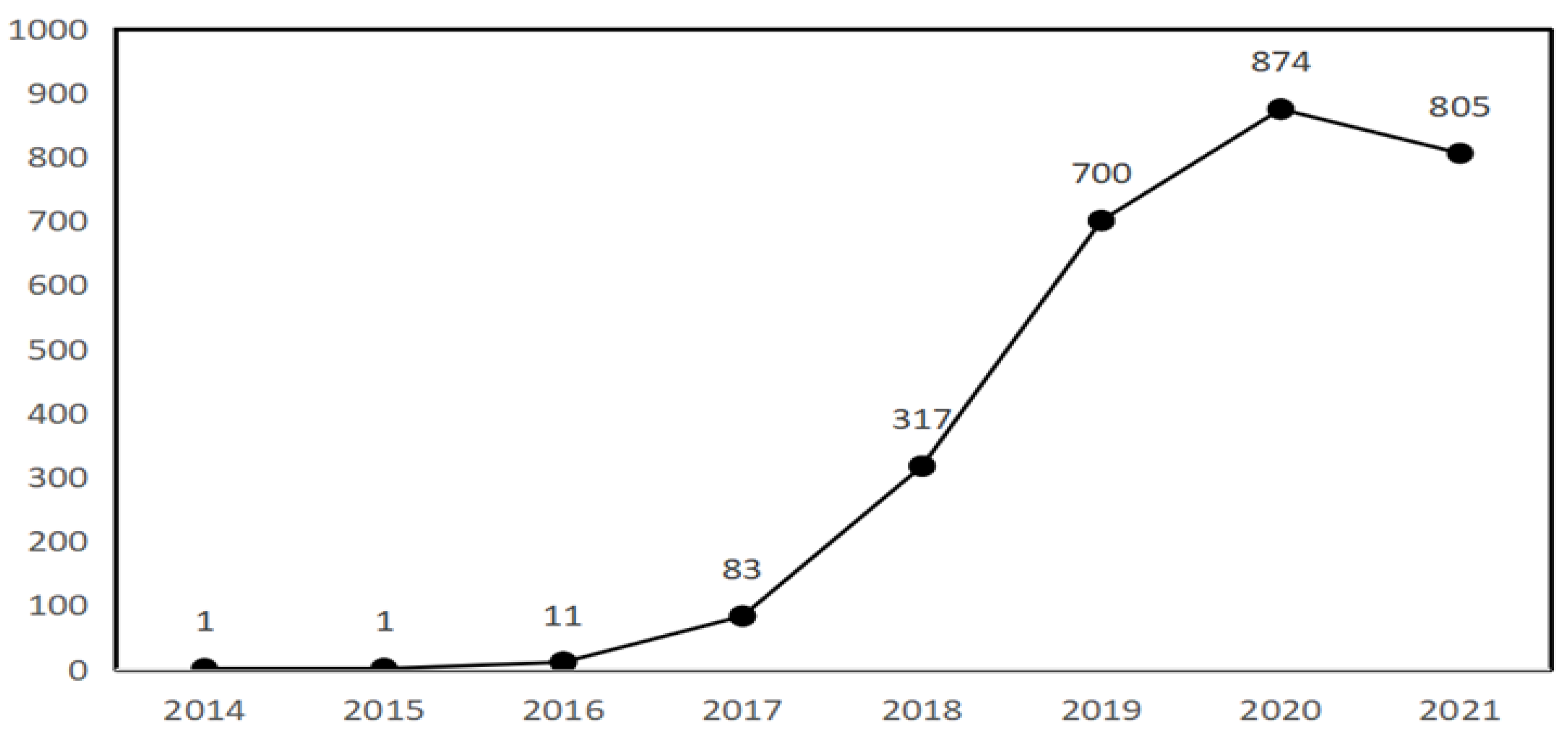


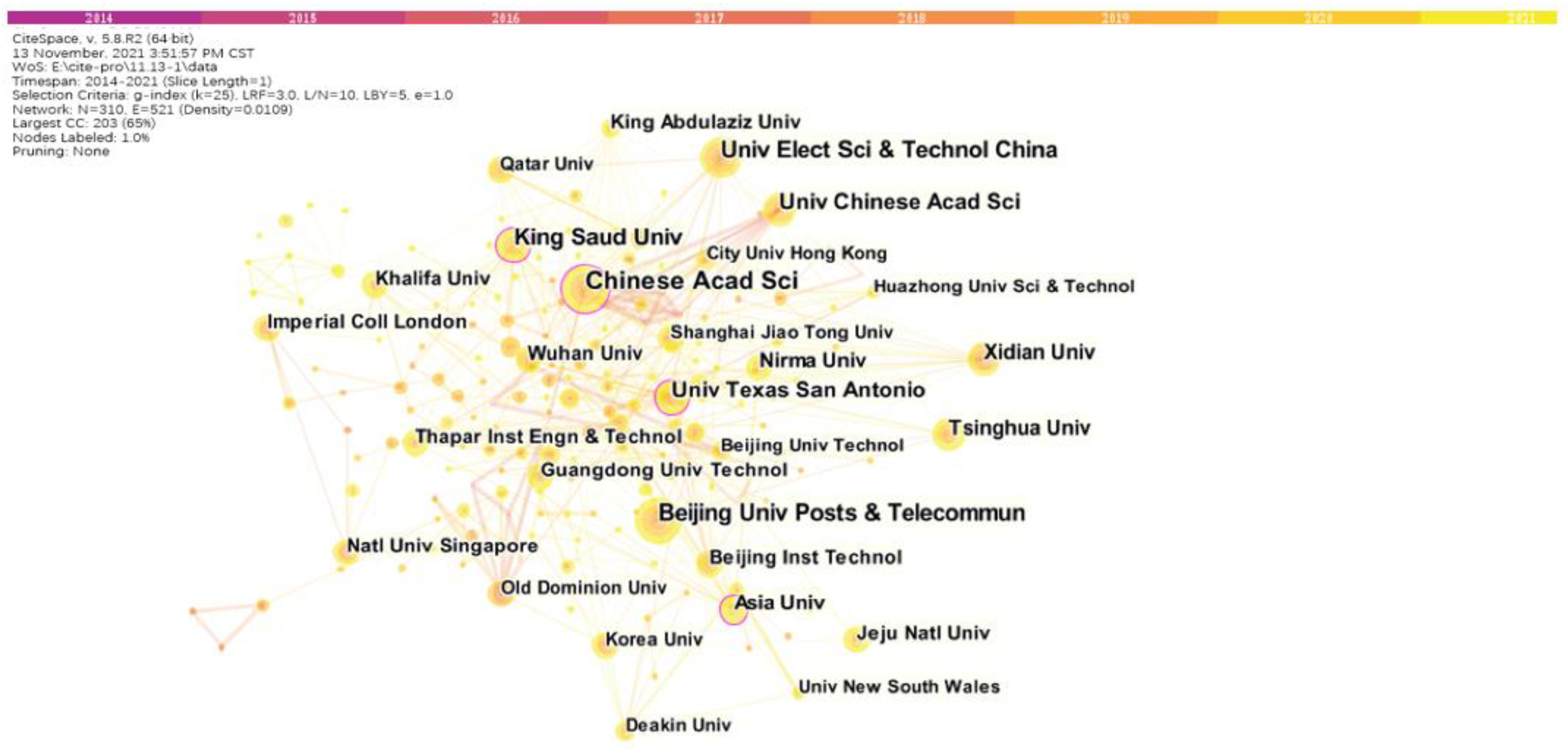
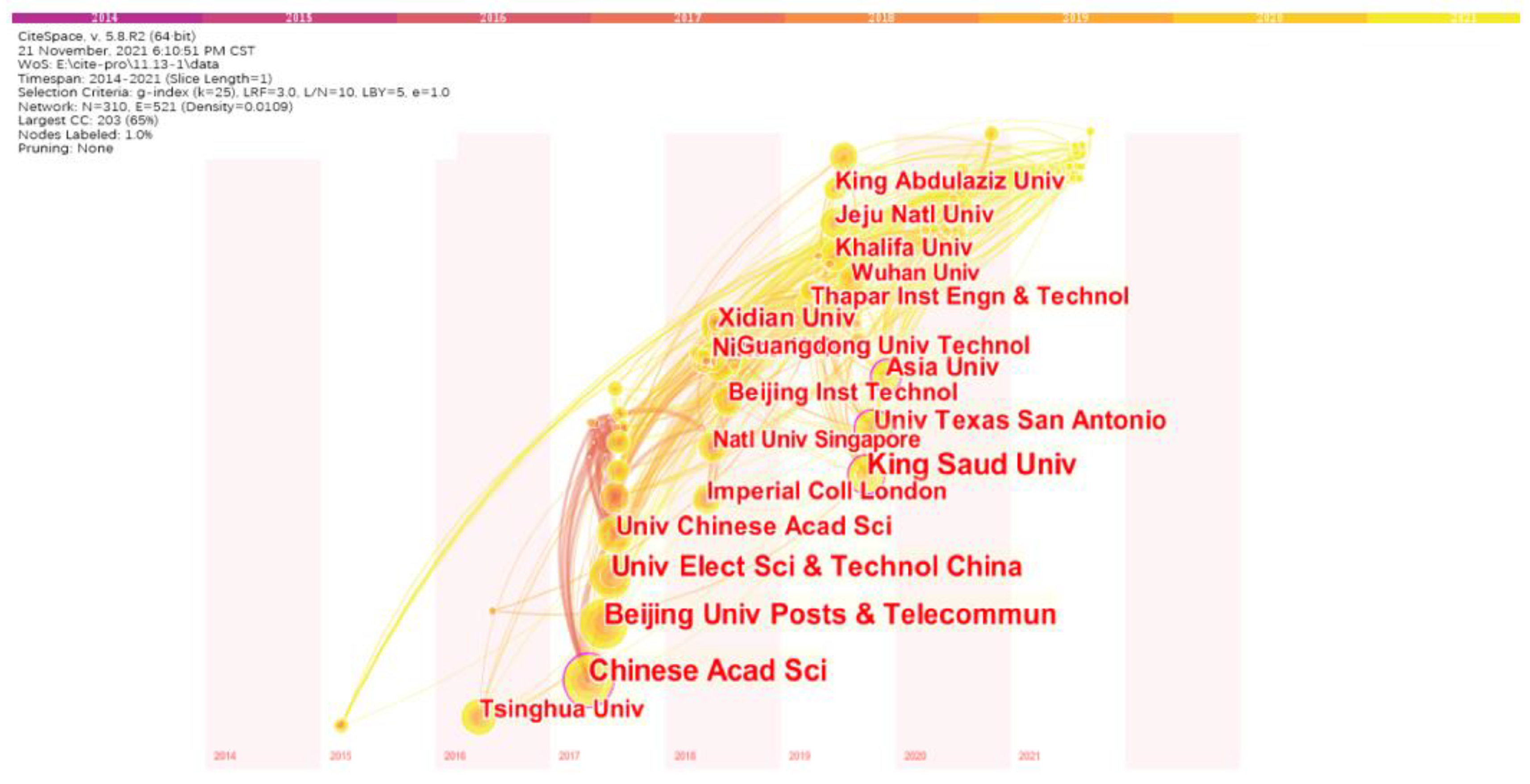

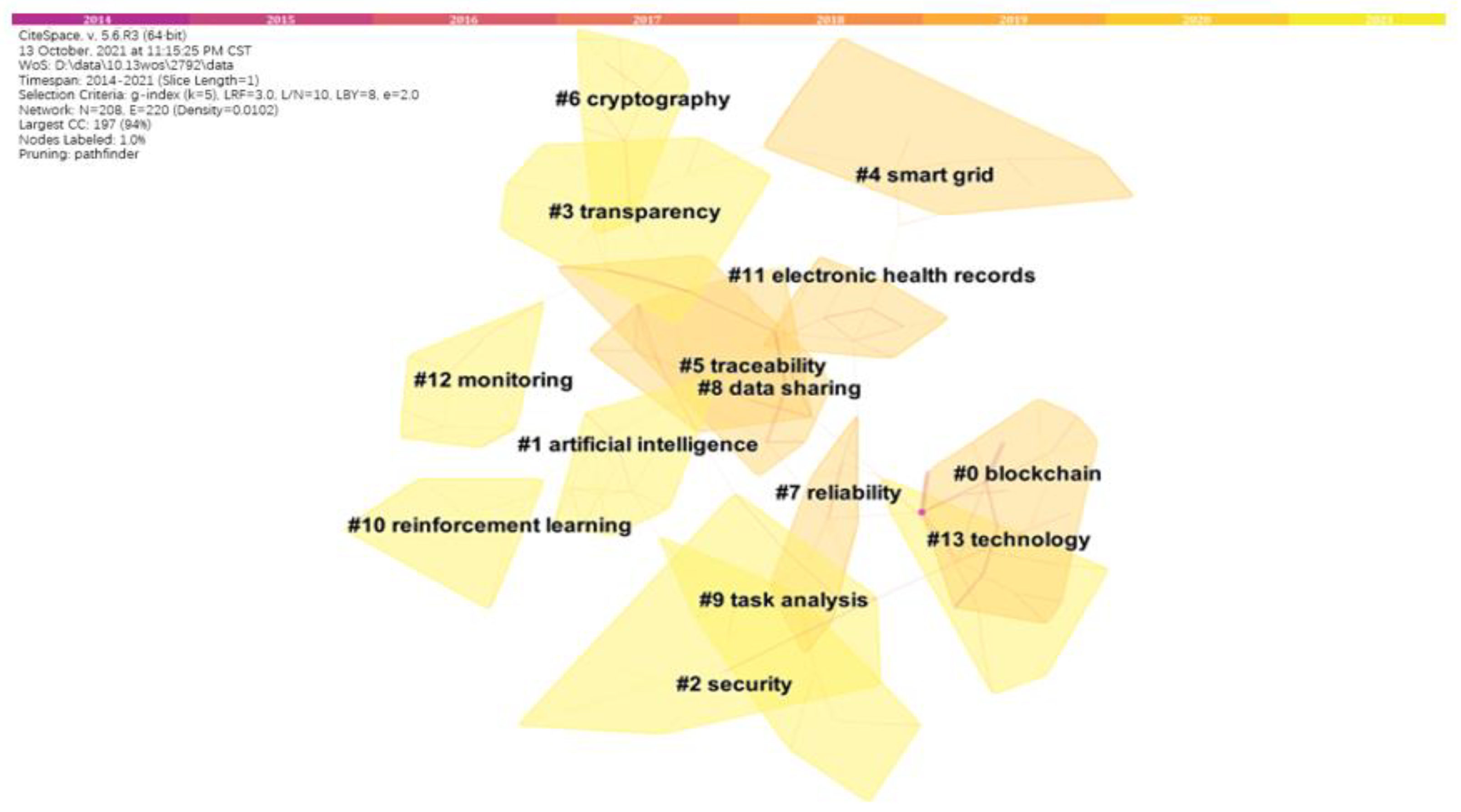
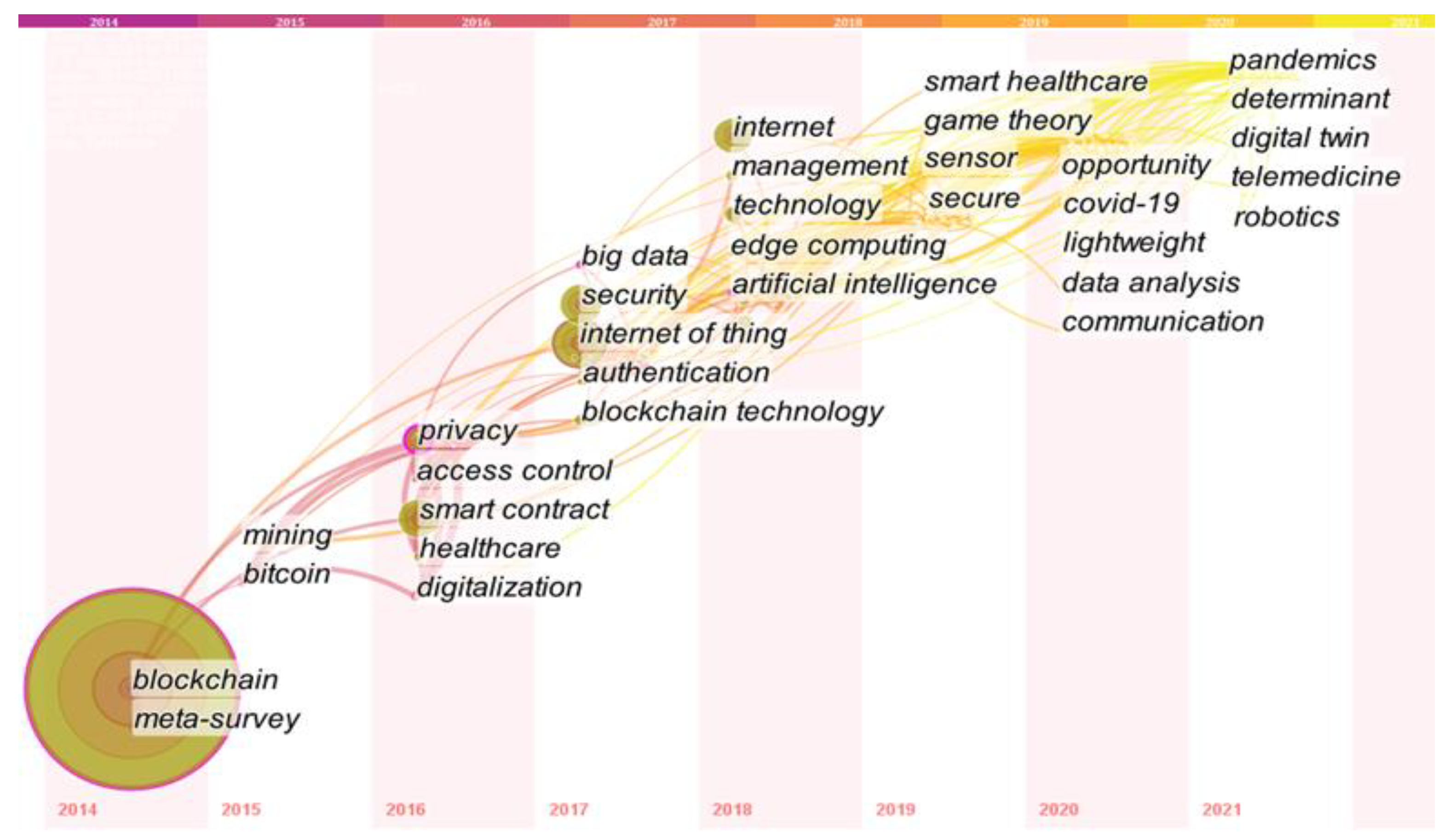

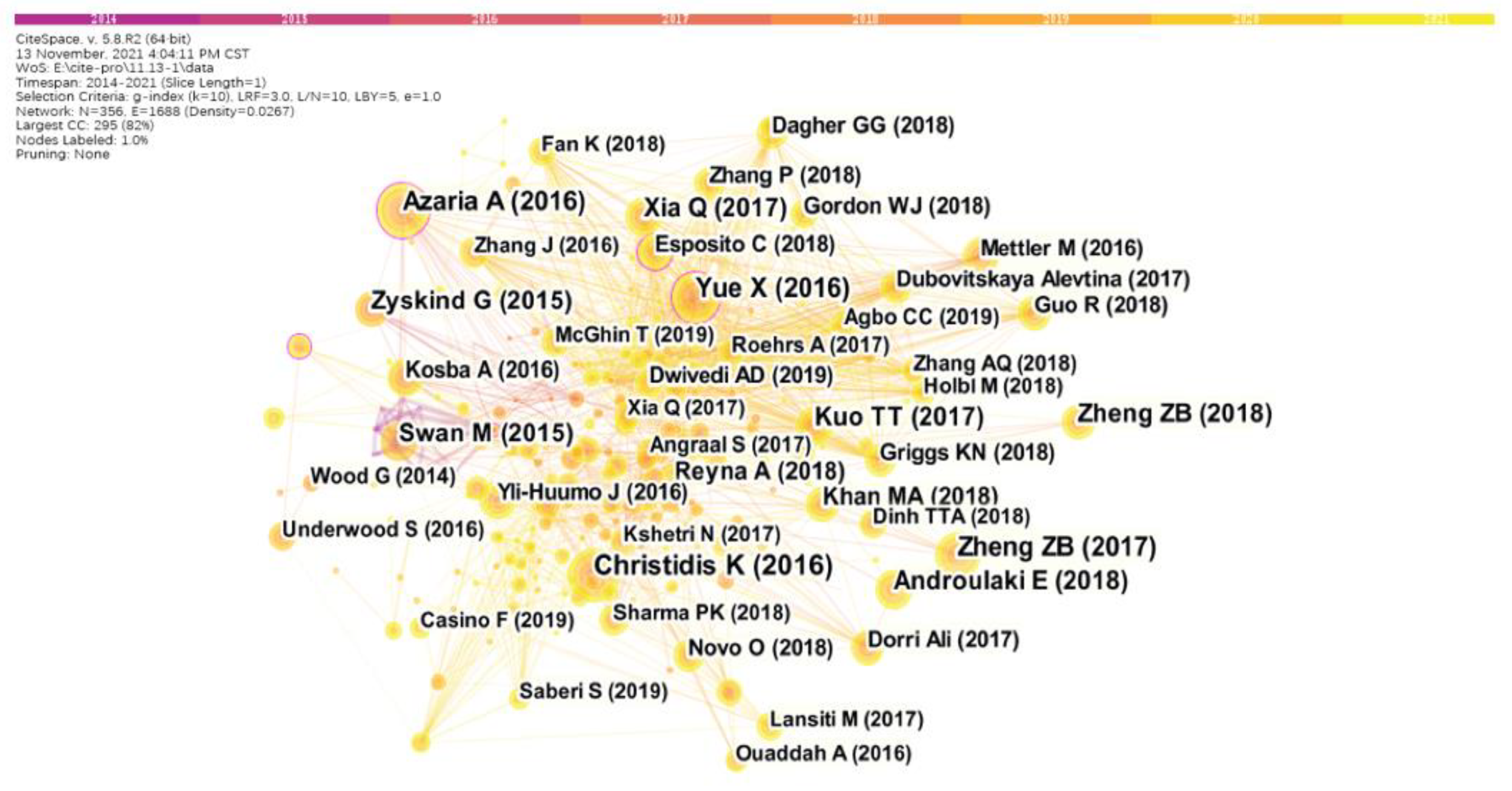
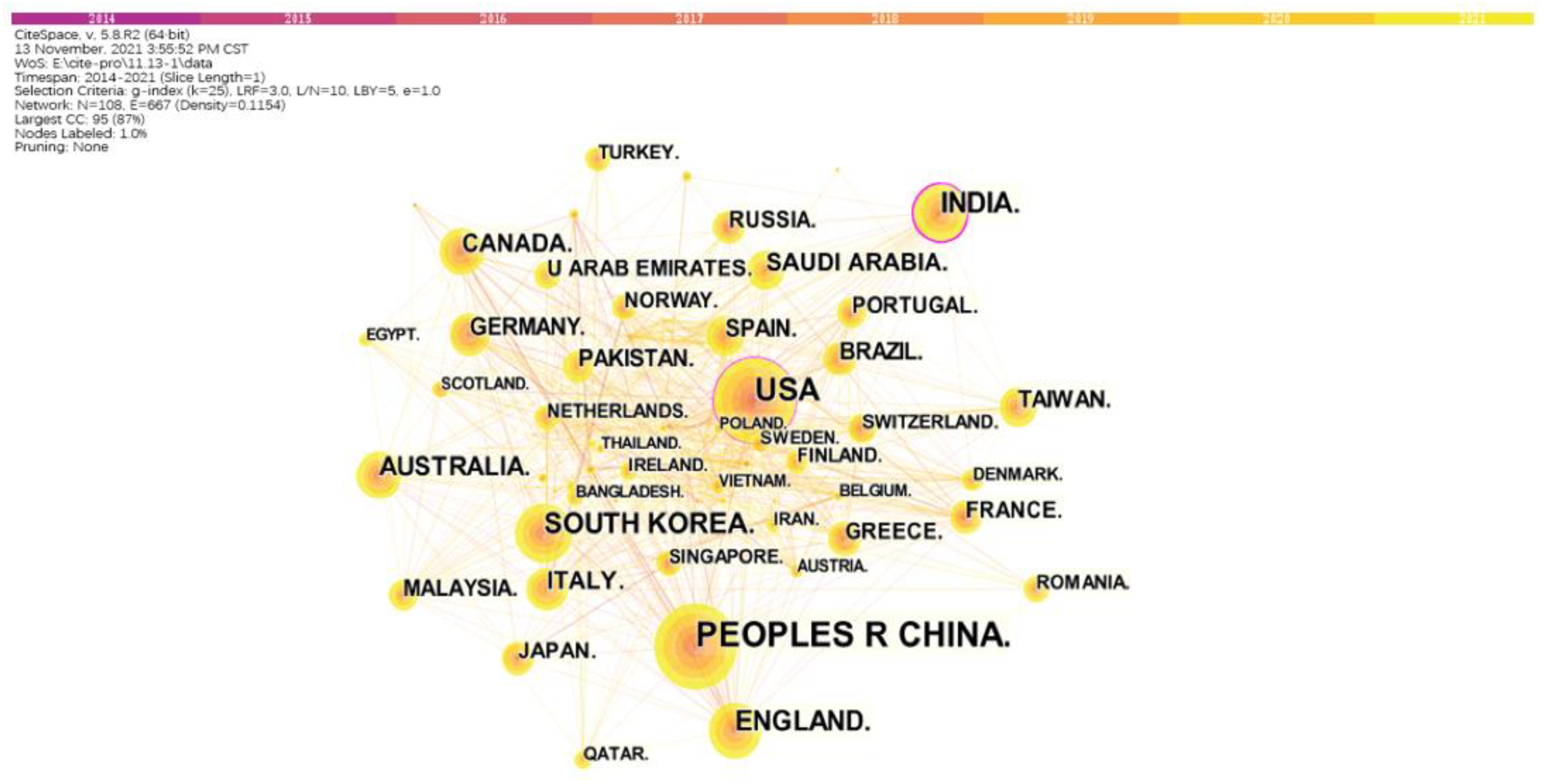
| Rank | Number of Articles | Betweenness Centrality | Average Year | Author |
|---|---|---|---|---|
| 1 | 26 | 0.01 | 2019 | Neeraj Kumar |
| 2 | 21 | 0 | 2020 | Sudeep Tanwar |
| 3 | 18 | 0.01 | 2019 | Kimkwang Raymond Choo |
| 4 | 17 | 0 | 2019 | Khaled Salah |
| 5 | 15 | 0 | 2020 | Ashok Kumar Das |
| 6 | 11 | 0 | 2019 | Mohsen Guizani |
| 7 | 11 | 0 | 2017 | Jong Hyuk Park |
| 8 | 10 | 0 | 2020 | Raja Jayaraman |
| 9 | 9 | 0 | 2019 | Xiaojiang Du |
| 10 | 9 | 0 | 2020 | Rajesh Gupta |
| 11 | 8 | 0 | 2019 | F. Richard Yu |
| 12 | 8 | 0 | 2019 | Gagangeet Singh Aujla |
| 13 | 8 | 0 | 2020 | Youngho Park |
| 14 | 8 | 0 | 2019 | Dohyeun Kim |
| 15 | 7 | 0 | 2019 | Yan Zhang |
| 16 | 7 | 0 | 2017 | Emmanuel Boateng Sifah |
| 17 | 7 | 0 | 2017 | Sachin Shetty |
| 18 | 7 | 0 | 2020 | Wenjuan Li |
| 19 | 6 | 0 | 2020 | Wei Liang |
| 20 | 6 | 0 | 2021 | Basudeb Bera |
| Rank | Number of Articles | Betweenness Centrality | Average Year | Institution |
|---|---|---|---|---|
| 1 | 47 | 0.17 | 2017 | Chinese Acad. Sci. |
| 2 | 39 | 0.2 | 2019 | King Saud Univ. |
| 3 | 37 | 0.06 | 2017 | Univ Elect. Sci. & Technol. China |
| 4 | 35 | 0.04 | 2017 | Beijing Univ. Posts & Telecommun. |
| 5 | 25 | 0.02 | 2017 | Univ. Chinese Acad. Sci. |
| 6 | 25 | 0.11 | 2019 | Univ. Texas San Antonio |
| 7 | 24 | 0.04 | 2018 | Xidian Univ. |
| 8 | 24 | 0.13 | 2019 | Asia Univ. |
| 9 | 23 | 0 | 2018 | Nirma Univ. |
| 10 | 22 | 0.01 | 2016 | Tsinghua Univ. |
| 11 | 20 | 0.04 | 2019 | Thapar Inst. Engn. & Technol. |
| 12 | 19 | 0.09 | 2019 | King Abdulaziz Univ. |
| 13 | 19 | 0 | 2019 | Jeju Natl. Univ. |
| 14 | 19 | 0.05 | 2018 | Beijing Inst. Technol. |
| 15 | 18 | 0.02 | 2018 | Guangdong Univ. Technol. |
| 16 | 18 | 0.07 | 2019 | Khalifa Univ. |
| 17 | 18 | 0.03 | 2018 | Imperial Coll. London |
| 18 | 17 | 0.02 | 2018 | Natl. Univ. Singapore |
| 19 | 17 | 0.04 | 2019 | Wuhan Univ. |
| 20 | 16 | 0.01 | 2018 | Korea Univ. |
| Rank | Frequency | Betweenness Centrality | Keyword | |
|---|---|---|---|---|
| 1 | 1943 | 0.54 | 2014 | blockchain |
| 2 | 530 | 0.39 | 2017 | internet of things |
| 3 | 411 | 0.26 | 2017 | security |
| 4 | 387 | 0.02 | 2016 | smart contract |
| 5 | 364 | 0.09 | 2018 | internet |
| 6 | 272 | 0.24 | 2016 | privacy |
| 7 | 191 | 0.12 | 2018 | challenge |
| 8 | 186 | 0.04 | 2018 | technology |
| 9 | 154 | 0.13 | 2018 | management |
| 10 | 145 | 0.07 | 2018 | system |
| 11 | 135 | 0.02 | 2018 | framework |
| 12 | 128 | 0.01 | 2017 | blockchain technology |
| 13 | 119 | 0.02 | 2017 | authentication |
| 14 | 117 | 0.02 | 2016 | healthcare |
| 15 | 104 | 0.18 | 2016 | access control |
| 16 | 103 | 0.02 | 2017 | ethereum |
| 17 | 101 | 0.32 | 2017 | big data |
| 18 | 95 | 0.84 | 2017 | cloud computing |
| 19 | 92 | 0.14 | 2017 | architecture |
| 20 | 91 | 0.01 | 2017 | model |
| Cluster ID | Scale | Betweenness Centrality | Average Year | Main Keywords |
|---|---|---|---|---|
| 0 | 24 | 1 | 2017 | blockchain (40.03, 1.0 × 10−4); ethereum (34.11, 1.0 × 10−4); IoT (32.89, 1.0 × 10−4); smart contract (28.35, 1.0 × 10−4); bitcoin (18.54, 1.0 × 10−4); cryptocurrency (18.06, 1.0 × 10−4); healthcare (17.9, 1.0 × 10−4); internet of things (14.04, 0.001) |
| 1 | 16 | 0.92 | 2019 | artificial intelligence (22.13, 1.0 × 10−4); machine learning (17.99, 1.0 × 10−4); deep learning (17.81, 1.0 × 10−4); IoT-oriented infrastructure (11.63, 0.001); big data (8.9, 0.005); cps (7.92, 0.005); security and privacy (7.43, 0.01); cyber-physical system (6.31, 0.05) |
| 2 | 16 | 0.934 | 2019 | security (12.66, 0.001); surveillance (8.44, 0.005); circular economy (8.44, 0.005); built environment (8.44, 0.005); ethereum (7.43, 0.01); internet of things (IoT) (7.27, 0.01); servers (5.09, 0.05); machine learning (4.57, 0.05) |
| 3 | 16 | 0.978 | 2019 | transparency (20.49, 1.0 × 10−4); readiness (12.68, 0.001); adoption (12.68, 0.001); supply chain management (9.82, 0.005); contracts (9.5, 0.005); initial coin offering (8.95, 0.005); IoT (7.81, 0.01); permissioned blockchain systems (6.33, 0.05) |
| 4 | 15 | 0.937 | 2019 | smart grid (32.24, 1.0 × 10−4); energy trading (25.77, 1.0 × 10−4); renewable energy (19.31, 1.0 × 10−4); software-defined networking (19.31, 1.0 × 10−4); consensus mechanism (12.74, 0.001); electric vehicles (9.13, 0.005); tactile internet (7.48, 0.01); decision making (7.48, 0.01) |
| 5 | 15 | 0.924 | 2018 | traceability (27.53, 1.0 × 10−4); intel sgx (18.12, 1.0 × 10−4); decentralization (14.64, 0.001); supply chains (12.89, 0.001); p2p (12.07, 0.001); incentive mechanism (12.07, 0.001); logistics (10.1, 0.005); supply chain (7.26, 0.01) |
| 6 | 13 | 0.895 | 2019 | cryptography (8.75, 0.005); data integrity (8.75, 0.005); protocols (8.12, 0.005); peer-to-peer computing (8.12, 0.005); detection (7.84, 0.01); IoT security (7.84, 0.01); privacy (7.04, 0.01); internet of vehicles (6.55, 0.05) |
| 7 | 13 | 0.942 | 2018 | reliability (22.3, 1.0 × 10−4); cloud computing (12.47, 0.001); industry 4.0 (11.01, 0.001); e-health (9.07, 0.005); service interoperability (6.07, 0.05); proactive forensics (6.07, 0.05); log security (6.07, 0.05); its (6.07, 0.05) |
| 8 | 12 | 0.972 | 2017 | data sharing (22.65, 1.0 × 10−4); access control (18.4, 1.0 × 10−4); attribute-based encryption (15.95, 1.0 × 10−4); distributed ledger technology (13.34, 0.001); privacy (11.95, 0.001); interoperability (10.84, 0.001); healthcare applications (10.39, 0.005); synchronization (10.39, 0.005) |
| 9 | 12 | 0.968 | 2019 | task analysis (33.29, 1.0 × 10−4); resource allocation (22.09, 1.0 × 10−4); edge computing (21.13, 1.0 × 10−4); computational modeling (20.24, 1.0 × 10−4); servers (18.91, 1.0 × 10−4); resource management (17.44, 1.0 × 10−4); mobile blockchain (11.03, 0.001); resource pricing (11.03, 0.001) |
| 10 | 12 | 0.919 | 2020 | reinforcement learning (31.9, 1.0 × 10−4); cybersecurity (23.57, 1.0 × 10−4); pandemics (14.69, 0.001); artificial intelligence (ai) (12.54, 0.001); covid-19 (12.33, 0.001); digital twin (11.04, 0.001); IoT (7.72, 0.01); blockchain (7.51, 0.01) |
| 11 | 11 | 0.85 | 2018 | electronic health records (21.02, 1.0 × 10−4); electronic health record (10.82, 0.005); authorization (9.7, 0.005); hyperledger fabric (8.27, 0.005); electronic medical records (6.52, 0.05); oauth (5.97, 0.05); ict (5.97, 0.05); sleep (5.63, 0.05) |
| 12 | 11 | 0.901 | 2019 | monitoring (11.68, 0.001); medical services (11.6, 0.001); sensors (10.81, 0.005); industries (10.05, 0.005); hospitals (9.37, 0.005); bim (8.54, 0.005); information and communication technology (8.54, 0.005); health 40 (8.54, 0.005) |
| 13 | 11 | 0.956 | 2018 | technology (13.22, 0.001); distributed ledger (8.43, 0.005); smart contract (6.43, 0.05); system (6.3, 0.05); social sustainability (6.3, 0.05); health care (5.87, 0.05); auditing (4.97, 0.05); indicators (4.97, 0.05) |
| Rank | Frequency | Betweenness Centrality | Year | Source Publication |
|---|---|---|---|---|
| 1 | 260 | 0.05 | 2016 | Christidis, K., 2016, Blockchains and smart contracts for the Internet of things, Ieee Access, V4, P2292, doi:10.1109/Access.2016.2566339 [18] |
| 2 | 198 | 0.1 | 2016 | Azaria, A., 2016, MedRec: Using Blockchain for medical data access and permission management, Proceedings 2016 2nd International Conference on open and big data–OBD 2016, V0, P25, doi:10.1109/OBD.2016.11 [19] |
| 3 | 179 | 0.12 | 2016 | Yue, X., 2016, Healthcare data gateways: found healthcare intelligence on blockchain with novel privacy risk control, J. Med Syst., V40, P0, doi:10.1007/s10916-016-0574-6 [20] |
| 4 | 162 | 0.03 | 2017 | Zheng, Z.B., 2017, An Overview of Blockchain Technology: Architecture, Consensus, and Future Trends, Ieee Int Congr. Big, V0, P557, doi:10.1109/BigDataCongress.2017.85 [21] |
| 5 | 149 | 0.01 | 2018 | Androulaki, E., 2018, Hyperledger fabric: A distributed operating system for permissioned blockchains, EUROSYS 18: Proceedings of the Thirteenth EUROSYS Conference, V0, P0, doi:10.1145/3190508.3190538 [22] |
| 6 | 143 | 0.03 | 2017 | Kuo, T.T., 2017, Blockchain distributed ledger technologies for biomedical and health care applications, J. Am Med. Inform ASSN, V24, P1211, doi:10.1093/jamia/ocx068 [23] |
| 7 | 133 | 0.02 | 2018 | Zheng, Z.B., 2018, Blockchain challenges and opportunities: A survey, Int J. Web Grid. Serv., V14, P352, doi:10.1504/IJWGS.2018.095647 [24] |
| 8 | 132 | 0.08 | 2017 | Xia, Q., 2017, Medshare: Trust-Less medical data sharing among cloud service providers via blockchain, Ieee Access, V5, P14757, doi:10.1109/ACCESS.2017.2730843 [25] |
| 9 | 131 | 0.01 | 2015 | Zyskind, G., 2015, Decentralizing privacy: using blockchain to protect personal data, 2015 IEEE Security and Privacy Workshops (SPW), V0, P180, doi:10.1109/SPW.2015.27 [26] |
| 10 | 126 | 0.05 | 2015 | Swan, M., 2015, Blockchain thinking the brain as a decentralized autonomous corporation, Blockchain Blueprint, V0, P0, Editorial Material [27] |
| 11 | 102 | 0.04 | 2018 | Khan, M.A., 2018, IoT security: review, blockchain solutions, and open challenges, Future Gener. Comp. Sy., V82, P395, doi:10.1016/j.future. 2017.11.022 [28] |
| 12 | 95 | 0.03 | 2018 | Reyna. A., 2018, On blockchain and its integration with loT, Future Gener. Comp. Sy., V88, P173, doi:10.1016/j.future. 2018.05.046 [29] |
| 13 | 90 | 0.08 | 2016 | Mettler, M., 2016, Blockchain technology in healthcare the revolution starts here, 2016 IEEE 18th International Conference on E-health networking, V0, P520 [30] |
| 14 | 90 | 0.01 | 2018 | Dagher, G.G., 2018, Ancile: Privacy-preserving framework for access control and interoperability of electronic health records using blockchain technology, Sustain Cities Soc, V39, P283, doi:10.1016/j.scs. 2018.02.014 [31] |
| 15 | 89 | 0.03 | 2018 | Zhang. P., 2018, FHIRChain: Applying blockchain to securely and scalably share clinical data, Comput Struct Biotec, V16, P267, doi:10.1016/j.csbj. 2018.07.004 [32] |
| 16 | 88 | 0.03 | 2016 | Yli-Huumo, J., 2016, Smolander, K. Where is current research on blockchain technology? —A systematic review, PLOS ONE, V11, P0, doi:10.1371/journal.pone. 0163477 [33] |
| 17 | 88 | 0.12 | 2018 | Esposito, C., 2018, Blockchain: A Panacea for Healthcare Cloud-Based Data Security and Privacy? Ieee Cloud Comput, V5, P31 [34] |
| 18 | 88 | 0.01 | 2017 | Dorri, Ali, 2017, Blockchain for IoT security and privacy: The case study of a smart home, 2017 IEEE International Conference on Pervasive Computing and Communications Workshops (PerCom Workshops), V0, P618, doi:10.1109/PERCOMW.2017.7917634 [35] |
| 19 | 87 | 0.02 | 2016 | Kosba, A.; Miller, A.; Shi, E.; Wen, Z., Papamanthou, C., 2016, Hawk: The blockchain model of cryptography and privacy-preserving smart contracts. Inproceedings of 2016 symposium on security and privacy (SP), San Jose, pp. 839–858. [36] |
| 20 | 87 | 0.03 | 2016 | Kosba, A., 2016, Healthcare blockchain system using smart contracts for secure automated remote patient monitoring, P Ieee S Secur. Priv., V0, P839, doi:10.1109/SP.2016.55 [37] |
| 21 | 87 | 0.02 | 2018 | Griggs, K.N., 2018, A supply chain transparency and sustainability technology appraisal model for blockchain technology, J. Med Syst., V42, P0, doi:10.1007/s10916-018-0982-x [38] |
| Rank | Number of Articles | Betweenness Centrality | Average Year | Country/Region |
|---|---|---|---|---|
| 1 | 713 | 0.06 | 2016 | China |
| 2 | 509 | 0.19 | 2016 | USA |
| 3 | 304 | 0.26 | 2017 | India |
| 4 | 238 | 0.01 | 2015 | South Korea |
| 5 | 192 | 0.1 | 2016 | UK |
| 6 | 134 | 0.05 | 2016 | Australia |
| 7 | 123 | 0.07 | 2017 | Canada |
| 8 | 123 | 0.09 | 2018 | Saudi Arabia |
| 9 | 106 | 0.05 | 2016 | Italy |
| 10 | 87 | 0.05 | 2018 | Taiwan |
| 11 | 80 | 0.04 | 2017 | Germany |
| 12 | 78 | 0.08 | 2017 | Spain |
| 13 | 74 | 0.02 | 2017 | Brazil |
| 14 | 73 | 0.04 | 2018 | Pakistan |
| 15 | 70 | 0.05 | 2017 | France |
| 16 | 65 | 0.02 | 2018 | United Arab Emirates |
| 17 | 62 | 0 | 2017 | Japan |
| 18 | 58 | 0.01 | 2017 | Russia |
| 19 | 58 | 0.03 | 2017 | Greece |
| 20 | 56 | 0.09 | 2018 | Malaysia |
Publisher’s Note: MDPI stays neutral with regard to jurisdictional claims in published maps and institutional affiliations. |
© 2022 by the authors. Licensee MDPI, Basel, Switzerland. This article is an open access article distributed under the terms and conditions of the Creative Commons Attribution (CC BY) license (https://creativecommons.org/licenses/by/4.0/).
Share and Cite
Guo, M.; Huang, Z.; Wu, L.; Tan, C.L.; Peng, J.; Guo, X.; Chen, H. Application of Blockchain Technology in Environmental Health: Literature Review and Prospect of Visualization Based on CiteSpace. Technologies 2022, 10, 100. https://doi.org/10.3390/technologies10050100
Guo M, Huang Z, Wu L, Tan CL, Peng J, Guo X, Chen H. Application of Blockchain Technology in Environmental Health: Literature Review and Prospect of Visualization Based on CiteSpace. Technologies. 2022; 10(5):100. https://doi.org/10.3390/technologies10050100
Chicago/Turabian StyleGuo, Meiwen, Zhenheng Huang, Liang Wu, Cheng Ling Tan, Jianping Peng, Xingcheng Guo, and Hong Chen. 2022. "Application of Blockchain Technology in Environmental Health: Literature Review and Prospect of Visualization Based on CiteSpace" Technologies 10, no. 5: 100. https://doi.org/10.3390/technologies10050100
APA StyleGuo, M., Huang, Z., Wu, L., Tan, C. L., Peng, J., Guo, X., & Chen, H. (2022). Application of Blockchain Technology in Environmental Health: Literature Review and Prospect of Visualization Based on CiteSpace. Technologies, 10(5), 100. https://doi.org/10.3390/technologies10050100







